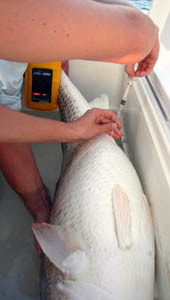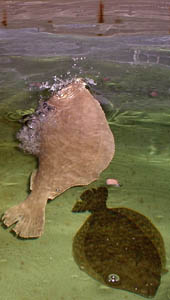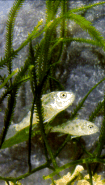The fish physiology group at the Fisheries and Mariculture Laboratory (FAML) is rooted strongly in basic research questions pertaining to the environment, ecology, and evolution of marine fishes. Our excellent holding facilities provide us with a unique ability to obtain and house a wide array of species, including pelagic species that are traditionally regarded as hard to work with. Our long-established captive spawning and larval rearing program also provides us with access to a number of different life stages.
Environmental Physiology
The ocean is a surprisingly diverse ecosystem that can range widely in a number of basic characteristics including oxygen saturation, pH, salinity and temperature. Environmental physiology focuses on the physiological mechanisms that allow fishes to survive in this often dynamic environment. Some of the specific research questions in environmental physiology currently being pursued at FAML include:
OCEAN ACIDIFICATION
-
Anthropogenic carbon dioxide release is resulting in gradual acidification of the marine environment with far-reaching consequences. We aim to assess these impacts on recreational and commercially relevant species of the Gulf Coast, such as red drum (Sciaenops ocellatus) and southern flounder (Paralichthys lethostigma). We investigate the mechanistic impacts on homeostatic processes in these animals, as well as their capacity to adapt to this gradual environmental change.
SALINITY AND WATER BALANCE
-
Estuaries along the Coastal Bend of South Texas are critical nursery areas for larvae and juveniles of many fish species. Interestingly, salinity can vary dramatically between estuaries, from extreme hypersalinity to near fresh water. Even within a single estuary the impacts of periodic freshwater inflow can change a given environment from hypersaline to hyposaline; two fundamentally different physiological challenges. We are investigating the mechanisms by which red drum, for example, are able to maintain osmotic balance in this dynamic environment, especially with respect to the very sensitive early life stages.
Eco-physiology
This emerging branch of physiology operates at the interface of physiology and ecology, focusing on questions that directly impact behavior, population dynamics, and fitness. Some specific research questions in eco-physiology currently being pursued at FAML are:
NUTRITION AND LARVAL SUCCESS
-
Proper nutrition is crucial to fish survival and success. We have found, using a suite of behavioral assays, that essential fatty acid composition of eggs is correlated with escape performance of larvae. We are currently investigating the role that parental diet plays in larval success by elucidating the dynamics of transfer of specific fatty acids from maternal diet to eggs and the specific fatty acid(s) that cause subsequent changes in larval survival skills.
SENSORY ECOLOGY
-
A crucial component of the success of larvae of estuarine-dependent fishes is their ability to locate suitable nursery habitat. For larvae of several local species, this is often the area in and around seagrass beds. We are currently investigating the environmental cues that red drum larvae use to locate seagrass beds, including auditory, olfactory, and visual cues. This work involves a combination of laboratory assays that measure directional and non-directional response combined with field experiments to examine behavior under natural circumstances.
EXERCISE AND PHENOTYPIC FLEXIBILITY
-
Fishes show a wide range in their capacity for exercise, from benthic sedentary species, such as southern flounder, to free-swimming pelagic species, like mahi-mahi (Coryphaena hippurus). We are examining the physiological traits and trade-offs of these lifestyles and the ability of specific traits to change in response to exercise regimens.
Evolutionary Physiology
This branch of research takes advantage of the substantial number of evolutionary lineages found in the marine and freshwater environments to investigate physiological adaptation throughout vertebrate radiation.
Some specific research questions currently being pursued at FAML are:
EVOLUTION OF RESPIRATORY GAS TRANSPORT IN WATER BREATHERS
Carbon dioxide transport is a multifaceted process involving a number of different proteins. Interestingly, the levels and localization of these proteins vary among teleosts, and even more so when compared to ancestral water-breathing organisms such as sharks, lampreys, and hagfishes. We are examining the adaptive significance of this variation, with specific interest in the role of red blood cells.











